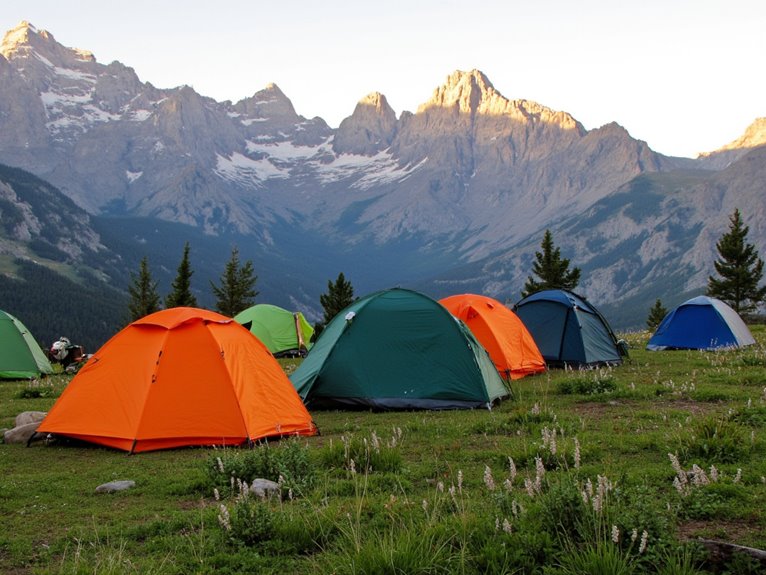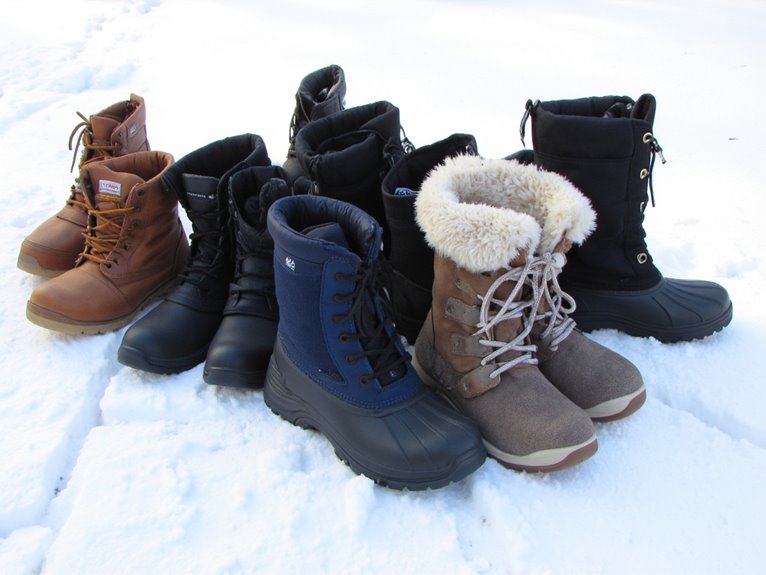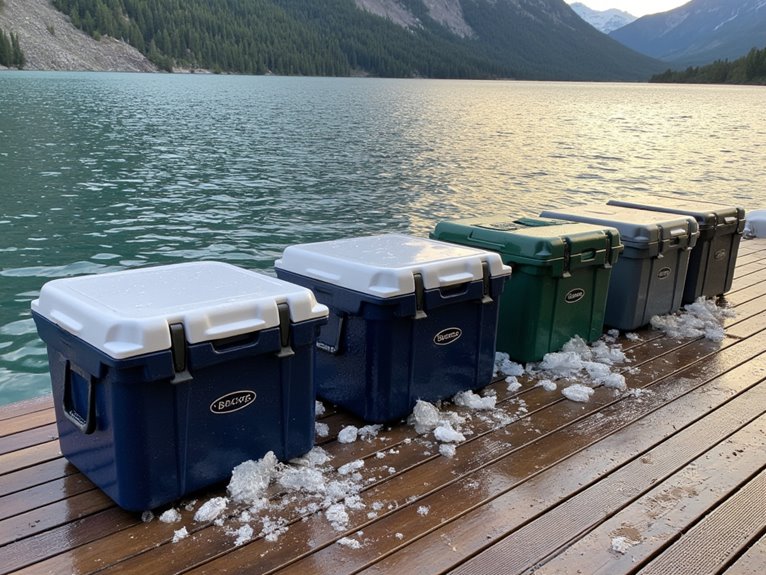Can Trail Runners Get Wet?
Trail runners can and will get wet, and it's essential to know how to handle wet conditions to stay safe and comfortable on the trails. Wet shoes can be restored with proper care, and understanding water resistance, techniques for trail running in rainy conditions, and waterproof gear can make all the difference. From choosing the right footwear to minimizing water absorption, every detail counts. As you venture into the world of wet trail running, discover the secrets to staying dry, safe, and confident on the trails, and tap the full potential of your next adventure.
We are supported by our audience. When you purchase through links on our site, we may earn an affiliate commission, at no extra cost for you. Learn more. Last update on 18th December 2025 / Images from Amazon Product Advertising API.
Understanding Water Resistance
When trail runners encounter water on their path, understanding water resistance becomes essential to maintaining speed, agility, and control.
Water resistance can be broken down into two components: form drag and friction drag.
Form drag refers to the resistance created by the runner's body shape, while friction drag is caused by the runner's movement through the water.
To minimize water resistance, trail runners can adopt techniques such as quick turnover, light footstrikes, and a slight lean forward.
Additionally, choosing the right footwear with good grip and drainage can also help reduce water resistance.
Trail Running in Rainy Conditions
When the rain pours down, trail runners must adapt to guarantee a safe and enjoyable experience.
In rainy conditions, it's vital to take additional precautions to minimize risks and maximize comfort.
Rainy Day Precautions
Rain-soaked trails demand heightened awareness, as reduced visibility and slippery surfaces require trail runners to adapt their pace and footing to avoid accidents.
When running in the rain, it's essential to prioritize safety above all else.
To minimize risks, consider the following precautions:
Reduce speed: Slow down to compensate for reduced traction and visibility.
Choose familiar trails: Avoid exploring new routes in rainy conditions to minimize navigation risks.
Stay visible: Wear bright or reflective clothing to increase visibility to other trail users.
Keep your eyes on the trail: Avoid distractions and maintain focus on the path ahead.
Waterproof Gear Essentials
In addition to exercising caution on rainy trails, selecting the right gear can make all the difference between a miserable and enjoyable trail running experience, and a waterproof jacket is a must-have in any trail runner's arsenal.
Look for a breathable and lightweight jacket with a water-repellent treatment, such as Gore-Tex or similar technology.
Additionally, consider waterproof socks and trail running shoes with a waterproof membrane to keep your feet dry and comfortable.
Don't forget a waterproof backpack or hydration pack to keep your essentials dry.
Safety in Low Visibility
As visibility dwindles on rainy trails, it's essential to prioritize safety and adapt your running strategy to compensate for reduced sightlines.
Reduced visibility increases the risk of accidents, so it's crucial to take extra precautions.
To stay safe in low-visibility conditions, remember:
Slow down: Reduce your pace to give yourself more time to react to obstacles and changes in the trail.
Stay alert: Keep your senses heightened to detect potential hazards, such as slippery surfaces or fallen trees.
Use technology: Wear a headlamp or carry a flashlight to illuminate your path.
Buddy up: Run with a partner or group to provide mutual support and assistance if needed.
Wet Conditions and Shoe Materials
During wet conditions, the materials used in trail running shoes play a vital role in determining the overall comfort and performance of the runner.
Water-absorbing materials like suede and nubuck can become heavy and uncomfortable when saturated, while waterproof and breathable materials like Gore-Tex or eVent allow for moisture transfer, keeping feet dry and comfortable.
Trail runners should choose shoes with water-resistant materials to minimize water absorption, ensuring a more comfortable and efficient run.
Additionally, look for shoes with drainage holes to allow water to escape, reducing the weight and discomfort of waterlogged shoes.
Caring for Soaked Trail Runners
When trail runners get soaked, proper care is vital to maintain their performance and extend their lifespan.
Effective drying, removal of excess moisture, and restoration of water repellency are essential steps to revive your wet trail runners.
Drying Wet Trail Runners
Drying wet trail runners requires prompt attention to prevent bacterial and fungal growth, which can lead to unpleasant odors and compromise the shoes' performance and longevity. When drying your trail runners, it's essential to take the right steps to preserve their quality and extend their lifespan.
- Remove the insoles and laces to facilitate airflow and speed up the drying process.
- Use a clean towel or cloth to gently blot excess moisture from the shoes, paying attention to the tongue, toe box, and midsole areas.
- Stuff the shoes with paper towels or newspaper to absorb moisture and maintain their shape.
- Air dry the shoes away from direct sunlight to prevent fading or discoloration.
Removing Excess Moisture
To prevent waterlogged trail runners from becoming a breeding ground for bacteria and fungi, it's essential to remove excess moisture as quickly as possible.
The first step is to gently blot the shoes with a towel, focusing on the tongue, collar, and midsole areas. Avoid rubbing, as this can push water deeper into the materials.
Next, stuff the shoes with newspaper or paper towels to absorb moisture. For tougher cases, use a desiccant like silica gel packets or uncooked rice to draw out moisture.
Finally, allow the shoes to air dry away from direct sunlight, ensuring good air circulation to speed up the drying process.
Restoring Water Repellency
After a thorough drying process, restoring water repellency is essential to maintaining the performance and integrity of your trail runners. This step is vital to guarantee your shoes continue to provide the necessary protection and comfort for your next adventure.
To restore water repellency, follow these simple steps:
- Apply a fabric protector: Reapply a fabric protector or waterproofing spray to the entire shoe, paying special attention to the tongue, toe box, and seams.
- Use a waterproofing cream: Apply a waterproofing cream specifically designed for footwear to the upper material, following the manufacturer's instructions.
- Treat the midsole and outsole: Apply a midsole and outsole treatment to maintain their water-repelling properties.
- Reapply regularly: Regular reapplication of these treatments will guarantee your trail runners remain water-repellent and ready for the next trail adventure.
Drying and Storage Techniques
Properly stowed away, trail running shoes can quickly regain their lightweight and breathable nature, making them ready for the next adventure.
To guarantee this, it's essential to implement effective drying and storage techniques.
Begin by removing the insoles and laces, allowing air to circulate and speeding up the drying process.
Store the shoes in a well-ventilated area, away from direct sunlight and heat sources.
Avoid using heat to speed up drying, as this can cause materials to degrade.
Instead, let the shoes air dry naturally, or use a fan to gently circulate air.
Proper storage and drying techniques can notably extend the lifespan of your trail running shoes, keeping them in top condition for your next excursion.
Waterproofing Treatments and Products
Trail runners can bolster their shoes' defenses against moisture with a range of waterproofing treatments and products, from Nikwax and Scotchgard to homemade concoctions. These treatments can significantly reduce water absorption, keeping feet drier and more comfortable during wet trail runs.
Improved water resistance: Waterproofing treatments create an invisible barrier that repels water, reducing absorption and keeping feet dry.
Enhanced durability: By protecting the materials from water damage, waterproofing treatments can extend the lifespan of your shoes.
Better breathability: Many waterproofing treatments allow moisture to escape, preventing the buildup of sweat and bacteria.
Increased confidence: With water-resistant shoes, you can tackle wet trails with confidence, knowing your feet will stay dry and comfortable.
Common Misconceptions About Wet Shoes
Wet shoes can be a trail runner's worst nightmare, but misconceptions about them often lead to unnecessary anxiety and poor decision-making.
One common misconception is that wet shoes are ruined forever. Not true! With proper care, wet shoes can be restored to their former glory.
Another misconception is that wet shoes are breeding grounds for bacteria and fungi. While it's true that moisture creates an ideal environment for microorganisms, regular cleaning and drying can prevent infestations.
Extending the Life of Wet Shoes
Every trail runner should know that a swift and thorough cleaning immediately after a soggy adventure is essential to extending the life of wet shoes. This crucial step helps prevent damage from dirt, debris, and bacteria that can cause shoes to deteriorate quickly.
Air dry, don't heat dry: Avoid using heat to speed up the drying process, as it can cause materials to degrade.
Use a soft-bristled brush: Gently remove dirt and debris from the shoe's surface to prevent scratches.
Stuff shoes with newspaper: This helps maintain their shape and absorbs moisture.
Store them properly: Keep shoes in a well-ventilated area, away from direct sunlight, to prevent fading and damage.



